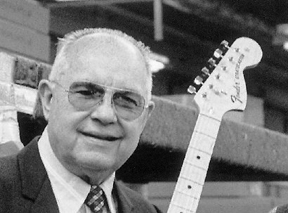Leo Fender Interview (1977)
by Joelle Steele (Nancy Martelli)
After begging and cajoling, I finally got the opportunity to speak with the elusive Leo Fender in Fullerton, California. Fender is best known for his Telecaster and Stratocaster guitars that are the choice of many noted rock and blues guitarists, like Muddy Waters, Eric Clapton, Jeff Beck, George Harrison, Keith Richard, Jimmy Page, the late Jimi Hendrix, and many other greats.

NM: I hear you were born here in Fullerton.
LF: Yes, at the time it was in Fullerton, but now it’s part of Anaheim.
NM: What was your childhood like?
LF: I was born on a truck farm, so vegetable growing. It was a normal childhood, but I lost my eye when I was 8, and that was a difficult adjustment. But it kept me out of World War II, which was the time when I was in the early stages of inventing and manufacturing guitars and amps.
NM: Were you musical as a child?
LF: Yes, I took piano lessons when I was a kid, then I played sax in the high school band. And I really liked – still like – country and western music.
NM: When did you start playing guitar?
LF: I don’t. Not at all.
NM: Really? So how did you get so interested in creating guitars?
LF: As a kid, I was interested in electronics, mainly radio. That led to amplifying sound. The guitars came much later.
NM: Did you study electronics?
LF: No, I learned on my own, tinkering with radios mostly. Became a ham radio operator. I worked as an accountant for awhile, but then I took out a loan on my car and opened my own radio shop in 1938. Built amps for musicians, public address systems. Electric pickups. Repaired radios and sound systems.
NM: What was K&F?
LF: Well, I was the “F” and the “K” was Doc Kauffman. He was a musician and also an inventor. He had worked at Rickenbacher and owned a local music store. We started K&F with money from selling a license for a record changer we invented. We built amplified Hawaiian guitars and a lap steel guitar with an electric pickup that I designed. We patented a solid-body guitar, but never did anything with it. It was during World War II, and the materials to build things were in short supply. After the war, we started manufacturing amplifiers and electric steel guitars – a challenge for us.
NM: What happened to Doc?
LF: Doc and I went our separate ways in 1946. It was an amicable split. And I continued manufacturing the steel guitars and amps, even though I was faced with some pretty hefty financial problems at the time.
NM: When did you finally build your first solid-body electric guitar?
LF: While I was manufacturing the steel guitars and amps, I was tinkering with the solid-body guitar idea. I was trying to use some of the components of the steel guitars. In 1948, I finally built it. It had one pickup. It was called the Esquire at first, but later I added a second pickup and it became the Telecaster. It was mostly popular with country and western guitarists.
NM: What made this type of electric guitar so popular back then?
LF: It could be heard over the other instruments in the big bands of the time. Musicians played guitars in those bands, but most of their sound was drowned out by all the horns. With the duo-pickups, they stood out. Later on, there were a lot of small bands – combos – and they liked electric guitars because they could dominate other instruments entirely and become the main attraction, as in lead guitars.
NM: When did the Precision Bass enter into all of this?
LF: In 1950, 1951, between the Telecaster and the Stratocaster. It was a four-string electric bass with a humbucker single-coil pickup. It was also an answer to bringing volume to the bass. It was slow to catch on at first.
NM: How did the Stratocaster come to be?
LF: It was about 1952, and music was changing. There were other solid-body guitars around, but there was a growing demand for even greater volume, a faster neck, etc. Especially for country and western guitarists.
NM: And your competition was …?
LF: Mostly Rickenbacker and Les Paul, but there were a few others. I wanted to build a better Telecaster, but instead I decided to build a different guitar, and that was the Stratocaster. It had a tremolo arm – a “whammy” bar – and three pickups or voicings, with tone controls for two of them. This allowed different sound options for the neck, center, and bridge pickups. It went into production in 1954.
NM: How did you end up as part of CBS?
LF: Not part of CBS. I sold out to CBS in 1965 for $13 million. It became the Fender Musical Instruments Division of their record distribution arm. There was a non-compete clause, but I was a consultant to CBS for awhile.
NM: And Music Man came about just two years ago?
LF: Right. I helped finance a company that became Music Man, and I became its president.
NM: And now, bringing us up to date, what was this most recent change to the Stratocaster?
LF: Last Fall, a five-way switch for playing bridge-middle and neck-middle was added. It was in answer to how guitarists were already playing the Stratocaster, especially with today’s guitar-driven bands.
* * *
